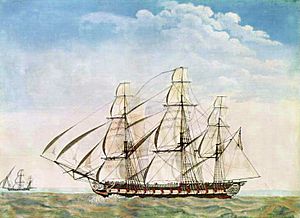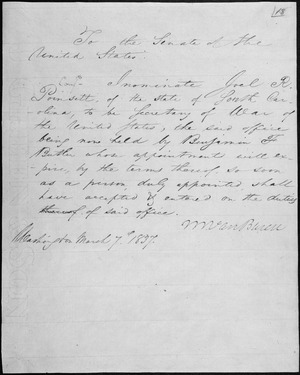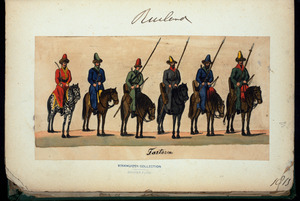Joel Roberts Poinsett facts for kids
Quick facts for kids
Joel Roberts Poinsett
|
|
|---|---|
 |
|
| 15th United States Secretary of War | |
| In office March 7, 1837 – March 4, 1841 |
|
| President | Martin Van Buren |
| Preceded by | Lewis Cass |
| Succeeded by | John Bell |
| United States Minister to Mexico | |
| In office June 1, 1825 – October 17, 1829 |
|
| President | John Quincy Adams Andrew Jackson |
| Preceded by | James Wilkinson (Envoy) |
| Succeeded by | Anthony Butler (Acting) |
| Member of the U.S. House of Representatives from South Carolina's 1st district |
|
| In office March 4, 1821 – March 7, 1825 |
|
| Preceded by | Charles Pinckney |
| Succeeded by | William Drayton |
| Personal details | |
| Born |
Joel Roberts Poinsett
March 2, 1779 Charleston, South Carolina, U.S. |
| Died | December 12, 1851 (aged 72) Stateburg, South Carolina, U.S. |
| Political party | Democratic |
| Spouse | Mary Izard Pringle |
| Parents |
|
| Education | University of Edinburgh Royal Military Academy, Woolwich |
Joel Roberts Poinsett (March 2, 1779 – December 12, 1851) was an American doctor, diplomat, and botanist. He was the first U.S. representative sent to South America. He also served in the South Carolina government and the U.S. Congress.
Poinsett became the first U.S. Ambassador to Mexico. He was a leader who wanted South Carolina to stay part of the United States during a big disagreement called the Nullification Crisis. Later, he served as Secretary of War for President Martin Van Buren. He also helped start the National Institute for the Promotion of Science, which was an early version of the Smithsonian Institution.
Contents
Early Life and Journeys
Joel Roberts Poinsett was born in 1779 in Charleston, South Carolina. His father, Elisha Poinsett, was a rich doctor. Joel studied in Connecticut and at the University of Edinburgh in Scotland. He learned many languages, law, and military skills.
Traveling in Europe
In 1800, Poinsett came back to Charleston. He wanted to join the military, but his father did not agree. His father wanted him to become a lawyer. So, Poinsett began studying law with a famous lawyer named Henry William DeSaussure.
However, Poinsett was not interested in law. In 1801, he convinced his parents to let him travel around Europe. He visited many countries, including France, Italy, and Switzerland. In Switzerland, he stayed with Jacques Necker, a former French finance minister.
In 1803, Poinsett traveled to Vienna, Austria, and then to Munich. He then heard sad news: his father had died, and his sister, Susan, was very sick. He quickly returned to Charleston. Sadly, his sister died shortly after he arrived. As the only child left, Poinsett inherited a large fortune.
Adventures in Russia
In November 1806, Poinsett arrived in St. Petersburg, Russia. The U.S. consul, Levett Harris, introduced him to Czar Alexander. The Empress asked Poinsett to visit her cotton factories. He gave ideas for improvements, which she accepted.
Poinsett believed that Russia's cotton industry would not do well. This was because it used serfs, who were like enslaved people. They did not get paid, so they had no reason to work hard. He thought serfdom also stopped Russia from having a strong navy or becoming an industrial country.
In January 1807, Czar Alexander invited Poinsett to dinner. The Czar offered him a job in the Russian government or army. Poinsett was not sure. The Czar told him to "see the Empire, acquire the language, study the people," and then decide. Poinsett loved to travel, so he agreed.
In March 1807, Poinsett began a long journey through southern Russia. He traveled with a friend and eight others. They went to Moscow, then by boat down the Volga River to Astrakhan. From there, they entered the Caucasus region. This area was dangerous due to different groups of people living there.
They were given a Cossack escort for safety. Later, they traveled with Tartar chiefs and a Persian merchant. This merchant was transporting young girls to harems in Turkey. The group believed having more people would make them safer.
Meeting a Khan
While traveling, a tribal chief stole some of Poinsett's horses. Poinsett bravely went to the Khan's court in Kuban to demand them back. The Khan was surprised to see a foreigner. He had never heard of the United States. Poinsett explained how great the U.S. was, talking about its geography. The Khan called President Thomas Jefferson the "Shah of America."
Poinsett said the theft would make the Khanate look bad. The Khan was impressed. He offered to punish the thief. But since the thief had brought such an important visitor, Poinsett suggested a pardon.
Poinsett's group then went to Baku on the Caspian Sea. He saw oil pits there. He thought this "petroleum" might be used for fuel someday. This made him one of the first Americans to visit the Middle East.
Poinsett also visited Erivan, where the Russian army was fighting. After spending time with the soldiers, he traveled through the mountains of Armenia to the Black Sea. He avoided Constantinople because of a war between Russia and the Ottoman Empire.
His journey was very difficult. Poinsett's health suffered, and only three of the nine travelers survived the trip. When he returned to Moscow, Czar Alexander offered him a job as a colonel in the Russian Army. However, Poinsett heard about a conflict between the U.S. and Britain. He wanted to return home to help his country.
Before leaving Russia, Poinsett met Czar Alexander one last time. The Czar said Russia and the United States should always be friends.
Serving in South America

From 1810 to 1814, Poinsett served as a "special agent" for the U.S. in Chile and Argentina. President James Madison sent him to learn about the revolutions there. These countries were fighting for independence from Spain.
Poinsett arrived in Santiago, Chile, in December 1811. He was the first official representative from a foreign government to visit Chile. His main goal was to protect American trade and citizens.
The Spanish rulers in Peru did not like Chile's new government. They seized American ships and goods. Poinsett learned that many American ships were taken in the Bay of Concepción. He decided he had to act.
Poinsett joined the Chilean army to fight against the Spanish. He was given the rank of general. He led a charge in the Battle of San Carlos, helping Chile win. He then went to Talcahuano, where the American ships were held. He attacked the town, and the Spanish surrendered.
In September 1813, the U.S. Frigate Essex arrived in Chile. Poinsett finally heard about the War of 1812 between the U.S. and Britain. He wanted to go home. However, British ships blocked the port. Poinsett was forced to stay in Chile.
He eventually found a way to return to the United States. He arrived back in Charleston on May 28, 1815.
Return to the U.S. and Politics
Back in Charleston, Poinsett focused on his own life. He became known as an expert on Latin American affairs. In 1816, his old friend General Jose Miguel Carrera from Chile asked for his help. Carrera wanted to start another revolution in Chile.
Poinsett tried to get the U.S. government to help the Spanish colonies. He also tried to get weapons for Carrera from a rich businessman, but it did not work out. Poinsett did arrange for Carrera to meet some of Napoleon's former officers. He also helped Carrera get weapons from a company in Philadelphia.
In August 1816, Poinsett traveled through the western United States. He visited important people like Congressman Henry Clay and Andrew Jackson. Poinsett's stories about Chile likely inspired Clay, who became a big supporter of independence for Spanish American countries.
Becoming a Congressman
While Poinsett was traveling, his friends nominated him for a seat in the South Carolina state legislature. He won! In April 1817, he was offered a job as a special commissioner to South America. However, Poinsett turned it down. He felt the mission would not lead to any big decisions, and he did not want to give up his new seat in the state legislature.
Poinsett believed in improving the country's infrastructure. He was part of the Committee on Internal Improvements and Waterways in South Carolina. He also led the South Carolina Board of Public Works. They planned to build roads and canals to connect the state's interior with the coast. This would help trade and bring business to Charleston.
In 1820, Poinsett was elected to the United States House of Representatives for Charleston. As a congressman, he continued to support internal improvements. He also wanted a strong army and navy. He pushed for building more warships. He was against the Tariff of 1824, which was a tax on imported goods.
First Ambassador to Mexico

From 1822 to 1823, Poinsett also served as a special envoy to Mexico. The U.S. government was worried about the new country's stability. Poinsett believed that a government like the U.S. republic was best for North American countries. He tried to influence the Mexican government.
In 1825, Poinsett became the first official U.S. Ambassador to Mexico. In 1828, he signed the first treaty between the U.S. and Mexico. This treaty set the border between the two countries.
Some U.S. leaders wanted more land. Poinsett was sent to try and buy new territories like Texas, New Mexico, and Upper California. However, Mexico refused to sell these areas. Poinsett wrote a book called Notes on Mexico about his time there.
He became involved in Mexico's political problems. He tried to help U.S. businesses and change the border. He also encouraged Mexico to create a constitution like the U.S. one. He was called back to the U.S. in 1830.
The Poinsettia Flower
While in Mexico, Poinsett saw a beautiful plant south of Mexico City. In Mexico, it is called Flor de Nochebuena (Christmas Eve flower). Poinsett was a plant lover. He sent samples of the plant to the United States. By 1836, this plant became widely known as the "poinsettia," named after him. A type of Mexican lizard, Sceloporus poinsettii, is also named in his honor.
Supporting the Union
Poinsett owned enslaved people. However, in 1830, he returned to South Carolina to support the idea of staying part of the United States during the Nullification Crisis. This was a time when South Carolina disagreed strongly with the federal government. Poinsett served in the state legislature again. He also secretly kept President Andrew Jackson updated on the situation in South Carolina. In 1833, Poinsett married Mary Izard Pringle.
Secretary of War

Poinsett served as Secretary of War from 1837 to 1841. In this role, he oversaw the forced removal of Native American tribes from their lands to areas west of the Mississippi River. This event is known as the Trail of Tears. He also managed the ongoing Seminole Wars against Native American groups.
He worked to make the army stronger by bringing groups of soldiers together. He also made sure the army's artillery regiments had proper equipment. After his term, he retired to his plantation in Georgetown, South Carolina, in 1841.
Later Life and Interests
Promoting Arts and Science
In the 1820s, Poinsett was a member of the Columbian Institute for the Promotion of Arts and Sciences. This group included important people like former presidents Andrew Jackson and John Quincy Adams. In 1825, he became a member of the American Academy of Arts and Sciences.
In 1840, he helped start the National Institute for the Promotion of Science and the Useful Arts. This group wanted to use money from a gift by James Smithson to create a national museum. They wanted the museum to show American history, technology, and natural resources. However, other groups wanted scientists, not politicians, to guide the new museum. This museum eventually became the Smithsonian Institution.
Freemasonry
Poinsett was a Master Mason. He played a big role in setting up Freemasonry in Mexico. He supported a type of Freemasonry that was connected to the political interests of the United States.
Death
Joel Roberts Poinsett died in Stateburg, South Carolina, in 1851. He passed away from tuberculosis, made worse by pneumonia. He is buried at the Church of the Holy Cross Episcopal Cemetery.
See also
 In Spanish: Joel Roberts Poinsett para niños
In Spanish: Joel Roberts Poinsett para niños
- Treaty of Limits (Mexico–United States)



